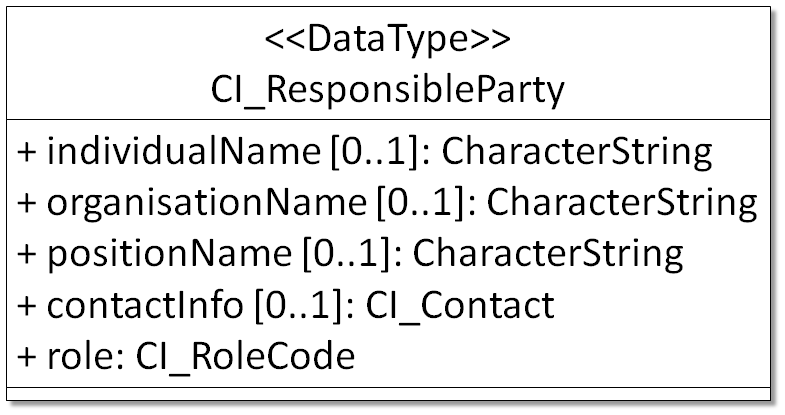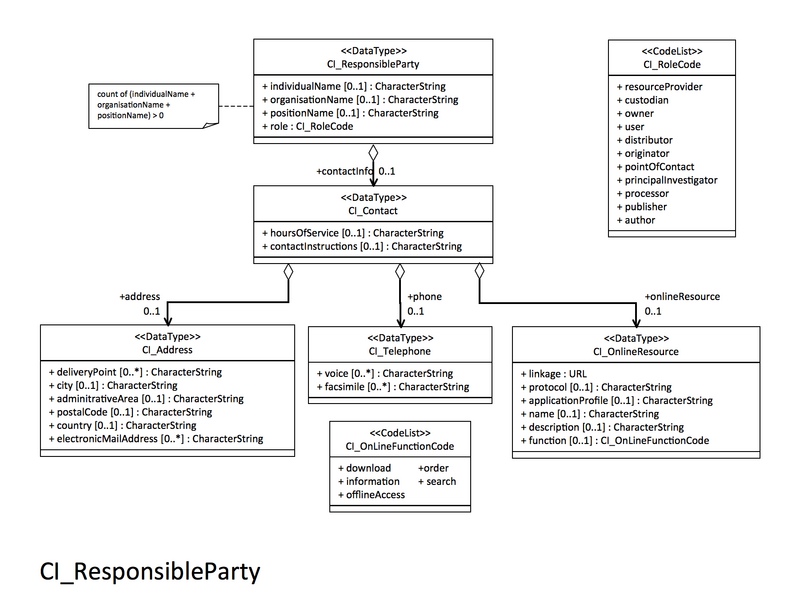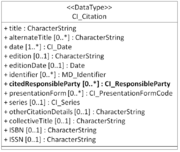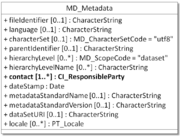I need to identify people and organizations in different roles
Many documentation dialects include mechanisms for connecting people and organizations to metadata records. There are two general approaches to these connections. The first involves including the roles of the people in the names of the metadata element's. For example, the NetCDF Attribute Convention for Data Discovery includes fields titled creator_name, creator_email, and creator_url. This approach makes it difficult to standardize because new standard elements must be added in order to add a new role, i.e. processor_name, processor_email, processor_URL. The second approach centers around a generic description of a person or an organization that includes an attribute that gives the role they play with respect to the resource being documented. This approach allows additions by extending the list of roles. See NetCDF, HDF, and ISO Metadata for more details on this approach.
Connecting people to resources is an important role of metadata. In addition, it is critical to describe people's role with respect to the resource.
Structure
The simple UML for the object is shown here. It includes one required element and four optional elements each of which can occur once. The CI_Contact includes information about physical and electronic addresses as well as a CI_OnlineResource as part of the contact information.
ISO Citations can include any number of organizations or people (citedResponsibleParties), each with one of the following roles: resourceProvider, custodian, owner, user, distributor, originator, pointOfContact, principalInvestigator, processor, publisher, or author (see Figure). For example, the principle citation for a metadata record, in the MD_Identification section, can include an author, a publisher, and any number of principal investigators. This is very different than the FGDC approach, where the idinfo section has a citation that can include, but not differentiate roles for, many originators and a single point of contact with no clear role definition.
The capability to have contacts with different roles in citations is very important at NGDC. We are trying to improve our utilization of the lineage sections of our metadata records. Those sections include sources which, in the FGDC, are citations. This works well if the sources are scientific papers, but in many cases, we receive unpublished data from a real person who has a phone number and an e-mail. There is no straightforward way to include that information in the FGDC standard. The ISO citation provides an easy way to do it.
Usage
Where are Responsibility objects? People can be connected to ISO metadata records in eight places, and in each CI_Citation. Those locations are shown in this Figure. In some cases the roles of the people are determined by where they are in the standard. In other cases, they are determined by the role code. See the Roles-by-Position vs. Roles-by-Code discussion below for more information.
| Usage | Description and Xpath |
Citation | The ISO CI_Citation object is used to refer to a variety of resources that are not included in a metadata record. It is modeled after a bibliographic reference and can include any number of organizations or people (responsibleParties) in any roles. Typically a CI_Citation includes originators or authors and a publisher. //gmd:CI_Citation/gmd:citedResponsibleParty |
Metadata Contact | The metadataContact is a person that creates and manages metadata for resources and services. This person generally has expertise in documentation standards and has enough experience and understanding of the resource to document it in partnership with the originator or resource contact. This responsibleParty generally has role = "custodian" or "pointOfContact". /gmi:MI_Metadata/gmd:contact |
| Resource Contact | |
| User Contact | |
| Processor | |
| Resource or Metadata Maintenance Contact | |
| Distributor | |
| Extension Contact |
ISO
The ISO dialect combines people and organizations into the CI_ResponsibleParty object, a flexible structure that supports many combinations of organizations and people. Most objects that include associated responsible parties can have any number, so, for example, a citation can have people identified in any or all of the roles listed in the CI_RoleCode code list.
The structure of the CI_ResponsibleParty is:
<gmd:CI_ResponsibleParty>
<gmd:individualName/>
<gmd:organisationName/>
<gmd:positionName/>
<gmd:contactInfo>
<gmd:CI_Contact>
<gmd:phone/>
<gmd:address>
<gmd:CI_Address>
<gmd:deliveryPoint/>
<gmd:city/>
<gmd:administrativeArea/>
<gmd:postalCode/>
<gmd:country/>
<gmd:electronicMailAddress/>
</gmd:CI_Address>
</gmd:address>
<gmd:onlineResource/>
<gmd:hoursOfService/>
<gmd:contactInstructions/>
</gmd:CI_Contact>
</gmd:contactInfo>
<gmd:role/>
</gmd:CI_ResponsibleParty>
Roles
CI_RoleCode
| ISO 19115 | Added in ISO 19115-1 |
+ resourceProvider | + sponsor |
Roles Crosswalk
This table reflects the MENDS Phase 3 voting results for 5.x items pertaining to the mapping of ECHO Roles to ISO Roles.
| ISO | DIF | ECS | ECHO |
|---|---|---|---|
| pointOfContact (/*/gmd:contact) | DIF AUTHOR | DIF AUTHOR TECHNICAL CONTACT | |
| originator (/*/gmd:identificationInfo/*/gmd:citation/gmd:CI_Citation/gmd:citedResponsibleParty) | Data Originator Producer | ||
| distributor (/*/gmd:distributionInfo/gmd:MD_Distribution/gmd:distributor/gmd:MD_Distributor/gmd:distributorContact) or pointOfContact (xPath) | TECHNICAL CONTACT | User Services, Distributor Archive | Data Center Contact Distributor |
| principalInvestigator (/gmi:MI_Metadata/gmd:identificationInfo/*/gmd:citation/gmd:CI_Citation/gmd:citedResponsibleParty) | INVESTIGATOR | Investigator Data Originator Producer | Investigator INVESTIGATOR |
| custodian (/gmi:MI_Metadata/gmd:distributionInfo/gmd:MD_Distribution/gmd:distributor/gmd:MD_Distributor/gmd:distributorContact) | Data Manager | ||
| pointOfContact (/mdb:MD_Metadata/mdb:dataQualityInfo/mdq:DQ_DataQuality/mdq:report/*/mdq:evaluation/mdq:DQ_FullInspection/mdq:evaluationProcedure/cit:CI_Citation/gmd:citedResponsibleParty) | Quality Assessment | ||
| pointOfContact (/*/mdb:acquisitionInformation/mac:MI_AcquisitionInformation/mac:instrument/mac:MI_Instrument/mac:citation/cit:CI_Citation/cit:citedResponsibleParty) | Instrument |
xPath Note: The xPaths included in this table use several wildcards. // means any path, so //gmd:CI_ResponsibleParty indicates a gmd:CI_ResponsibleParty anywhere in an XML file. /*/ indicates a single level with several possible elements. This usually indicates one of several concrete realizations of an abstract object. For example /*/gmd:identificationInfo could be gmd:MD_Metadata/gmd:identificationInfo or gmi:MI_Metadata/gmd:identificationInfo and gmd:identificationInfo//*/gmd:descriptiveKeywords could be gmd:identificationInfo/gmd:MD_DataIdentification/gmd:descriptiveKeywords or gmd:identificationInfo/srv:SV_ServiceIdentification/gmd:descriptiveKeywords.
| User | Edits | Comments | Labels |
|---|---|---|---|
| John Kozimor | 30 | 0 | 0 |
| Ted Habermann | 28 | 1 | 3 |
| Ross Bagwell | 1 | 0 | 0 |
| Kathleen Baynes | 0 | 1 | 0 |
Overview
The ISO standard offers a new and very powerful approach for attaching organizations and people to metadata records. The CI_Responsibility object describes people and organizations that are related to a resource and their roles. It is used throughout the ISO Standards to describe and provide contact information for people and organizations. This page will review the structure and usage options for the CI_Responsibility object.



